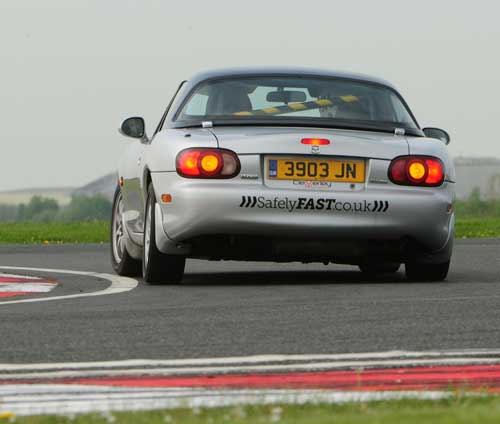Driving Notes
Throttle Steering
Every time you change the direction of travel you do so by rotating the car around a point in the centre of the car. At the novice and intermediate level the only way you can rotate the car is to turn the steering wheel.
In order to avoid understeer the intermediate driver may need to limit his corner speed prior to the apex to allow for sufficient steering angle to hit the apex. Throttle steering is a technique that allows you to rotate the car in a corner, independent of the steering input, by releasing a small amount of pressure on the gas pedal. (This differs from “power oversteer” – a technique applicable to high horsepower cars – that induces oversteer by increasing pressure on the gas pedal). Throttle steering allows for faster cornering speeds and earlier acceleration coming out of the corner.
In high performance driver education, novice and intermediate drivers are instructed to make a smooth rotation of the steering wheel on corner entry and mild constant throttle from corner entry to the apex. As you progress beyond intermediate you learn to apply “maintenance throttle,” so that car does not decelerate at all between corner entry and apex. This means that your speed at the turn-in point is the same as your speed at the apex. The application of the throttle during corner entry is critical as throttle steering is not possible if you are “coasting” – meaning you›re neither on the brake nor the gas. This is a critical point as throttle steering requires that you maintain throttle input throughout corner entry. Throttle steering requires that your speed during corner entry generates G-forces sufficient for your tyres to be at or near their grip limit during corner entry. At slower corner entry speeds or less than optimum utilisation of the tyres, you will not be able to achieve controlled oversteer – the mechanism responsible for rotating the car when throttle steering – when you lift off the throttle. Since your corner entry speed has placed your tyres at or near their grip limit increasing steering angle in any of the above three situations will likely cause the car to understeer. Because your foot is now applying pressure to the gas pedal you have the capability to subtly and smoothly slightly decrease pressure on that pedal.
To achieve throttle steering without changing your steering angle you must feather the gas pedal prior to reaching the apex. Breathing off the gas pedal requires a quick, smooth, slight decrease in pedal pressure. This results in a small amount of forward weight transfer. This forward weight transfer causes the front wheels to “bite” and the associated decrease in weight on the rear wheels allows the rear wheels to “slide” resulting in subtle, controlled oversteer. The ensuing rotation points the nose of the car towards the apex. All this magically happens without turning the steering wheel.
Often the fastest way around the corner is where the corner entry speed is high enough to initiate light understeer where during this point you would lift off and rotate rear tyres losing grip a tad to get back to the apex, in order to get back on power as soon as possible. With modern day data/video loggers you can see some of the fast or pro drivers using this technique with the throttle meter going down or almost off in the middle of the turn, before going back to full power.
It is important to emphasise that throttle steering requires smooth and gentle manipulation of the gas pedal. Your initial attempts at throttle steering will likely result in no oversteer at all. As your confidence increases you will likely have too little or too much oversteer. With practice though, you will find the balance and be able to make subtle adjustments in your car’s direction that will allow you to negotiate and exit corners faster. As we all know, the faster you exit the corner, the faster you go down straight.
John Norrington Experience
- 10+ years hands on teaching experience
- c.5,000 pupils to date
- Race licence holder over 40 years
- ARDS GRADE A Instructor
- MSA Level 2 Coach
- APDI member
- IAM member
- ATDO
- RoSPA member
- SDSA certified
- Pro Driver. Worked with many manufacturers/dealers, staff and customers on road and track driving, demonstrating and training.
Links:

Safely Fast’s Mazda MX5







